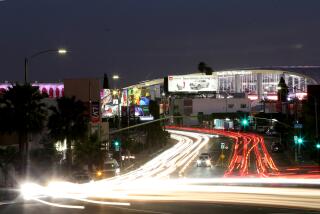Inglewood May Annex a Part of Lennox in Effort to Reduce Crime
- Share via
Inglewood hired a consultant this week to study the possibility of annexing part of Lennox, but community leaders in the unincorporated area said they oppose being gobbled up by their neighbor to the north.
Inglewood officials are looking into annexation as a way to reduce crime and blight they believe is spreading across the border from Lennox to Inglewood. But many residents of Lennox, a largely low-income, Latino community, fear that behind the annexation drive is a desire to turn residential neighborhoods into commercial developments, wiping out homes in their affordable community.
The Inglewood City Council voted Tuesday to pay the consulting firm of Christiansen & Wallace Inc. $39,000 to study the costs and benefits of annexation and make a recommendation to the council. A draft report is due within five months.
Along with an analysis of annexation options, the study will include a telephone survey to gauge residents’ reaction in Lennox. An annexation proposal requires an election in Lennox if more than 25% of the area’s registered voters were to oppose it on petitions. It must also win the approval of both the Los Angeles County Board of Supervisors and the Local Agency Formation Commission.
Lennox, bordered by Inglewood to the north and Hawthorne to the south, lies within both cities’ “sphere of influence,” a county planning term defining areas that local municipalities can attempt to annex. Inglewood may apply to annex the half of Lennox north of Lennox Boulevard, whereas Hawthorne would have a claim to the southern portion.
Hawthorne has put its annexation plans on the shelf because such a move would prove too costly, said City Manager Kenneth Jue. A city-sponsored study completed in 1988 found that annexation would cost $1.2 million a year more in city services than it would bring the city in property, sales and other taxes.
“As it stands now, Lennox would be more of a liability than an asset,” Jue said in an interview Tuesday.
While Inglewood officials await the consultant’s study, they remain convinced that annexation would bring benefits for residents in both communities.
Inglewood Councilman Garland Hardeman, whose district abuts the Lennox border, said annexation would allow Inglewood officials to address drug dealing, prostitution and other criminal activities that he said spill over into Inglewood from Lennox. Inglewood police are currently limited in what they can do in the area because of the different jurisdictions. Inglewood’s code enforcement, graffiti removal and other services would also help to clean up Lennox, he said.
But some community leaders in Lennox, a 1.25-square-mile area east of Los Angeles International Airport, do not embrace that analysis.
“That rationale does not convince me,” said Hector Carrio, a member of the board of the Lennox School District. “Inglewood is looking for a new source of revenue and (Lennox) is the best place. This is not what we want. We are looking for a way to improve our way of life. Inglewood is looking to improve its own city, not us.”
Carrio acknowledged that crime has been a serious problem in Lennox, but he said Inglewood has not cleaned up its drug dealing or prostitution either.
Carrio predicted that after annexation Inglewood would be too busy with its own problems to address Lennox’s needs. “We’re an orphan community now, and under annexation we would be the poor relative.”
James Kean, president of a neighborhood group called the Lennox Coordinating Council, said he fears that annexation of the area piecemeal would fragment the Lennox community. He said he prefers a recently released county redevelopment plan to annexation.
County planning officials say their plan to revitalize Lennox has two aims in mind: to upgrade residential neighborhoods through increased code enforcement, and to develop Lennox’s prime location near the airport and the intersection of the San Diego and as-yet-unopened Century freeways.
The county plan was soundly rebuffed by Lennox residents when it was proposed last year. However, the opposition decreased earlier this month with the release of a revised version that scaled back commercial development in residential neighborhoods.
Despite the revisions, many in Lennox remain fearful that words such as “revitalization” and “annexation” mask plans for the wholesale replacement of residential areas by industry. They maintain that because the bulk of Lennox’s population is disadvantaged and lacks political clout, the area is ripe for exploitation by commercial developers.
“Inglewood will probably tear out the whole area,” said Joe Rudy, a longtime Lennox resident who opposes both annexation by Inglewood and the county’s revitalization plan.
Inglewood officials maintain that they have no hidden agenda to wipe out Lennox’s homes.
“We have no current plans for Lennox,” said Councilman Jose Fernandez. “The council has not taken a position on annexation. We’re just studying it.”
Fernandez said the city will probably just attempt to annex small portions of Lennox to even out the jagged border in areas where the jurisdiction now changes in the middle of blocks.
In some areas along the Inglewood-Lennox border, Fernandez said, residents are not sure to which jurisdiction they belong.
“I don’t see this as a major threat,” Fernandez said. “It would be better for both sides if we have an even border and everyone knows on which side they live.”
More to Read
Sign up for Essential California
The most important California stories and recommendations in your inbox every morning.
You may occasionally receive promotional content from the Los Angeles Times.










